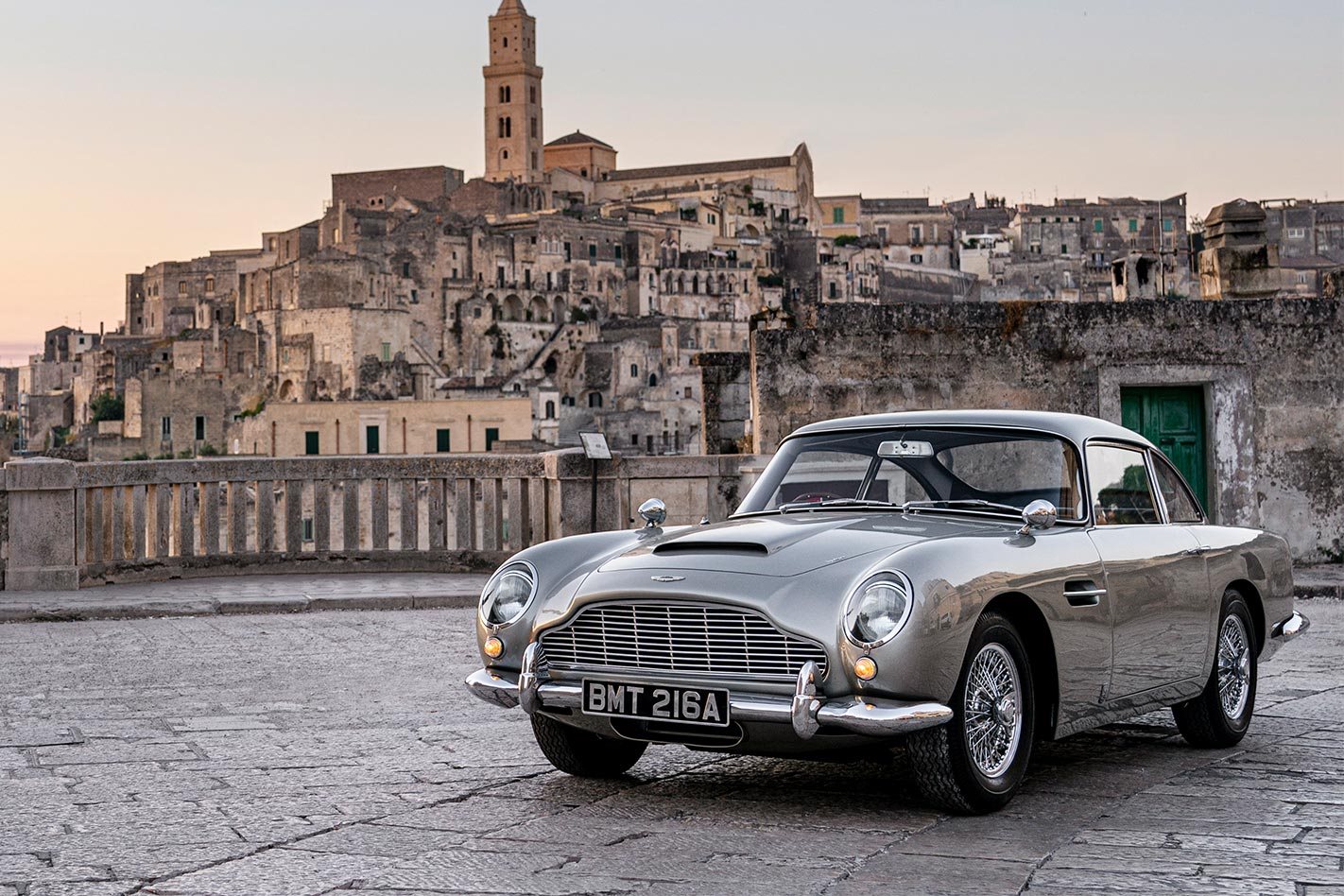In a cramped, unglamorous attic space, Daniel Craig is sitting on the floor, casual as you like. You can’t help but notice that he’s handsome but – no offence – not quite as smouldering as his big-screen persona; his face is covered in what resembles a grim, female-repelling case of teenage acne. To his credit though, he cracks a joke about it.
He’s down-to-earth, relaxed, and not the Daniel Craig we expected; not the guy who, a few years back, threw a high-profile celebrity strop, swearing blind he’d rather slit his wrists than make another Bond movie.
There’s a good reason for his hang-loose demeanour. This isn’t the Daniel Craig, simply a version of him, the next best thing.
Mark Higgins is a 48-year-old British rally champion turned full-time stunt driver, a job that now includes drifting, doughnuting and body-doubling on behalf of the world’s most famous fictional spy. And that hideous skin affliction? The spots are known in the trade as ‘motion capture’, a digital-dot system placed onto a stunt driver’s face during filming, allowing the actor’s mug to be grafted on later by the CGI team.
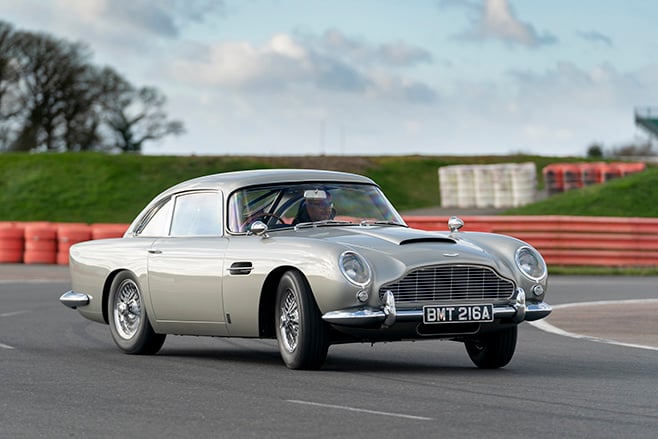
“We did use face masks in previous Bonds but they’re hard to get rid of digitally,” says Higgins.
It’s a blisteringly hot morning in the ancient, sandstone-washed city of Matera, southern Italy, back in September 2019. We’re on the set of the forthcoming Bond movie, No Time to Die, having been given super-rare, one-day-only permission to watch how 007 car stunts are stitched together.
Today’s scene, from which Higgins has taken a few minutes away to talk to Wheels, is being shot in a picture-postcard Italian piazza, albeit at a pace that would make some glaciers feel sprightly. It’s a segment that may or may not form part of the franchise’s now-signature, high-octane opening sequence (the production overlords are vague about plot details).
Bond and his iconic 1960s silver birch Aston Martin DB5 have just been chased through the skinny, decidedly car-unfriendly cobbled streets, and are now trapped in the square. The bad guys, one group emerging from an ’80s Range Rover Classic, the others a moody Jaguar XF sedan, are pummelling the Aston’s bodywork with machine-gun fire.
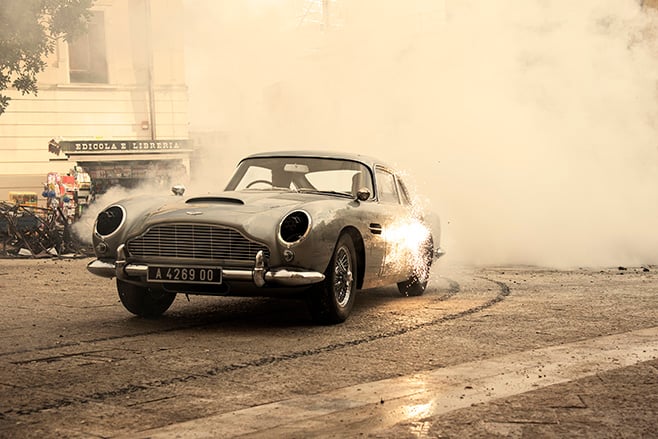
“It’s quite scary when people are coming at you with guns,” says Higgins, now on his fifth Bond outing. “Quite eerie when the bullets are bashing on the windscreen.”
Fortunately for him, and connoisseurs of sacred collectibles the world over, the Aston is 100 percent bulletproof. That’s because the DB5 currently being filmed is no ordinary model. It’s one of eight visually identical replica DB5s commissioned especially for No Time to Die. Built by Aston Martin’s special projects division in conjunction with the movie’s head of stunt cars, Neil Layton, each comes with carbonfibre bodywork and a steel spaceframe chassis. Modern rally suspension, transmission, and modern straight-six 268kW engine are standard, too; proper Q-cars, then.
The Aston rep, however, refuses to reveal the origin of said powerplant, and probably wouldn’t even if one of Bond’s foes put a gun to his head.
To withstand the various rigours of being a Bond stunt car, every replica is individually tweaked to suit a different scene: a car expected to perform a slide, for instance, will be specced differently to one involved in a high-speed chase. “The challenge here in Matera is you’ve got five or six different road surfaces that you’re adjusting the cars to all the time,” says Layton, who’s responsible for not just the DB5s, but 140-plus vehicles used in No Time to Die.
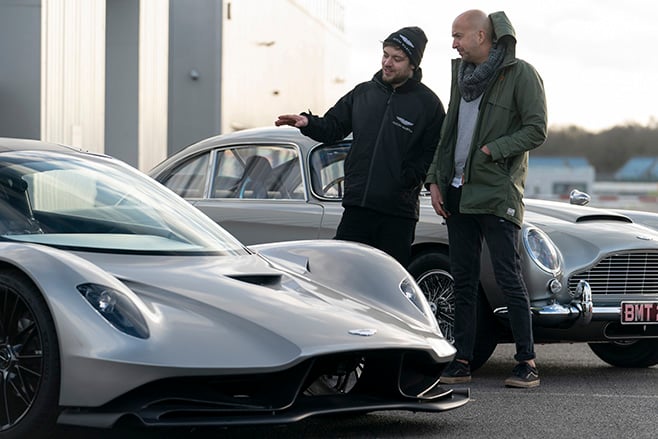
Mention Matera’s roads to Higgins and you’ll be met with a raised eyebrow and a wry smile worthy of any hammy Bond quip. On top of the contrasting surfaces, and all the problems that raises for stunt driving, the city’s streets and pavements are covered in a thin layer of dust, which is about as slippery as ice. The solution? Pour thousands of litres of Coca-Cola onto the roads to increase traction. “We spent about £70,000 [around A$135,000] on the stuff,” laughs Higgins. “The difference it makes is amazing, increasing grip levels by about 70 percent.”
A few multi-packs may be required this afternoon. Driving a stunt DB5, Higgins and his motion-control spots are scheduled to careen along a tiny street, and then drift into the piazza at high speed. The sequence is one of the juicy carrots the production company and Aston Martin used to lure Wheels to Italy. But one thing quickly learned about film sets is best-laid plans are often brutally laid to waste, even with a whispered production budget of around $2 million per day; even with 250 worker-bee crew members buzzing around.
As ominous black storm clouds gather over Matera’s rooftops, the crew are trying to record a scene in which Bond performs a doughnut in the DB5 while spraying his adversaries with bullets from headlight-concealed Gatling guns. In keeping with the general level of movie hocus-pocus, the DB5 – now straddled with scaffold poles – is being pushed through 360 degrees by four crew members to mimic the doughnut; there’s a hulking IMAX camera attached to the car’s flank, and even someone as deft as Higgins can’t be trusted to pull off the manoeuvre without killing a million-dollar piece of filming equipment.
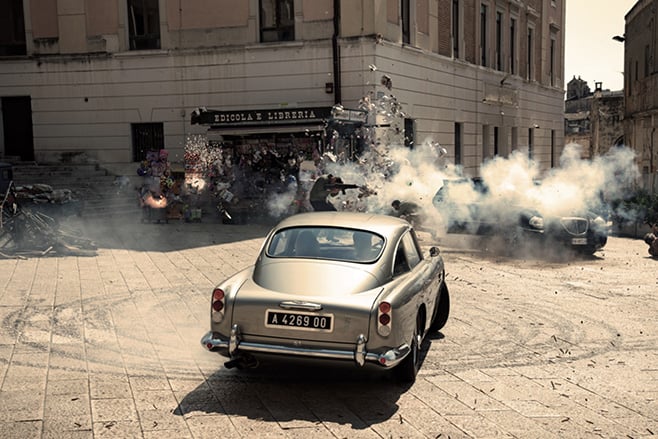
But some of the men are falling down on Matera’s notoriously slippery surfaces. Then the Gatling guns malfunction, dribbling bullets onto the piazza. Then rain stops play. The skies darken. The light levels are too poor to continue filming. We’re told we won’t get to see the drifting scene. Boo, hiss. We feel like throwing popcorn at someone.
We thought this is where the curtain would come down on our Bond adventure. Then, a few months later, an email popped into the Wheels inbox, inviting us to another one-off event; this time driving one of the stunt DB5s used in No Time to Die, along with an original model, plus an ’80s Aston Martin V8, the latest DBS Superleggera and a $1.9 million Valhalla hypercar – not due for release until 2021 – thrown in for good measure (although the latter is strictly look don’t drive). All of which are set to feature in No Time To Die when it hits cinemas around the world.
The UK’s Silverstone track during a Northern Hemisphere winter feels several reincarnated lifetimes away from summer in Matera. It’s bone-shakingly cold on the morning we arrive, just above freezing. The landscape is exposed and bleak. Its only redeeming feature is Aston Martin’s Test and Development Centre, which sits alongside Silverstone’s smaller Stowe circuit, where future Aston projects are put through their paces dynamically.
If 007 is the character around which the Bond series orbits, then Aston Martin is the marque at the centre of its universe – give or take a few hit-and-miss flirtations with Ford and BMW. And spiritually, the DB5 is the car that best captures the James Bond character; timeless, elegant, with a dab of upper-class ruffian. It was first driven by Sean Connery in 1964’s Goldfinger, followed by Thunderball in 1965, but then the 4.0-litre straight-six grand tourer mysteriously dropped out of favour – only to be resurrected in more recent years, most memorably in GoldenEye (1995), Casino Royale (2006) and then Skyfall (2012).
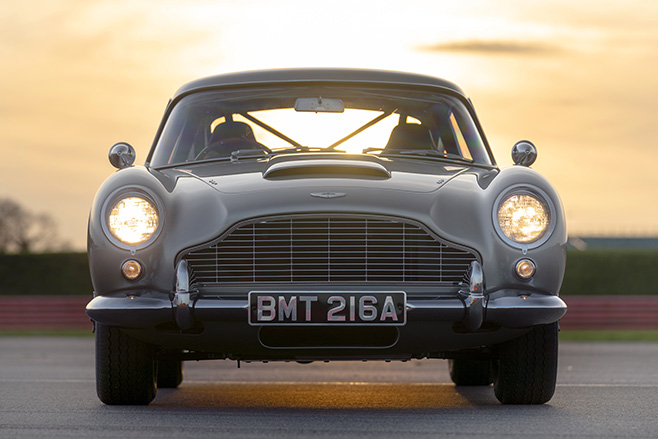
Last August, a DB5 used to promote Thunderball sold for $10.2 million at auction; a real-world example in Australia would fetch north of $1 million, but expect to see the letters POA on most for-sale ads. This isn’t the kind of information anyone needs floating around their head before escorting such a valuable slice of automotive history onto an icy English track…
We head into the Stowe circuit’s first corner in the DB5 too quickly, forgetting it’s a fiftysomething grand dame without the luxury of power steering, ABS brakes, or any of the other modern technology that fools the average man into thinking he’s got skills. Like all venerable older ladies, she demands to be treated with respect.
The gorgeous DB5 is clearly suited to theatrical arrivals outside St Tropez casinos, not track work; the seat is too close to the large, boat-like wooden steering wheel; the floor-hinged pedals are positioned at an awkward angle; bodyroll can be alarming at times. But making allowances for its age, and the level of technology available to Aston in that era, the DB5 remains a classy piece of engineering.
The 290kW, naturally aspirated straight-six produces a lovely rorty note when pushed along Stowe’s straights. And although the DB5 is no slouch – its 8.1 seconds from 0-100km/h made it one of the fastest production cars in the world in its time – this is a grand tourer designed to be driven at sensible speeds, a reminder of the days when life itself moved at a more refined pace.

The same cannot be said of its stunt-car cousin. Side by side, it’s virtually impossible to tell the difference between the replica and the original, save for the roll cage visible through the windows. But that’s where the DNA strands are snipped.
We’re strapped into the race harness, sink into the bucket seats, then blast onto the track, revelling in the stiffer spaceframe structure, the Ohlins rally suspension, the 500kg that’s been shaved from the original’s 1500kg weight. With its Herculean front-end grip, corners are now welcomed, not feared. There’s a huge hydraulic handbrake, which we’ve been warned not to touch, but the temptation is strong; almost worth an Aston life ban. It’s a deflating moment when we’re flagged into Stowe’s pit, a gentle reminder that other people want to play, too.
In the afternoon, as the weak winter sun dips towards the horizon, we jump into the two remaining Bond movie cars; the imposing Aston Martin V8, and the surprisingly chuckable DBS Superleggera. But when the time comes for the handful of assembled journalists to pick a favourite, it’s a simple two-way contest between the DB5s. What a pair of cars. What a day.
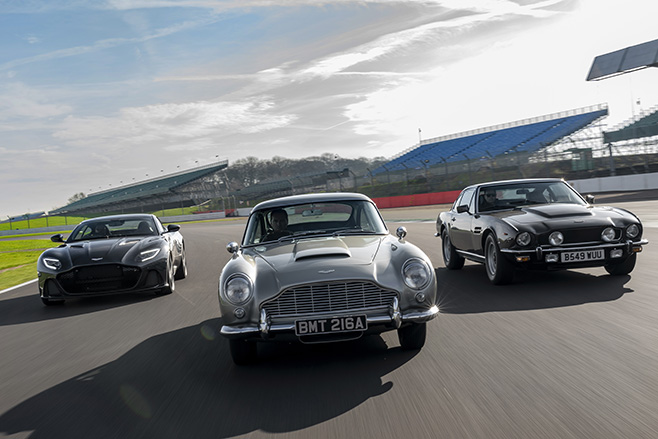
Just when we think it’s all over, a familiar face walks into the Aston test centre. His skin is a few tones pastier and now free of spots. We didn’t get to see him drift into an Italian piazza, but Mark Higgins is about to do something perhaps more thrilling: treat us to a hot lap in the DB5 stunt car.
Higgins, like all great driving artisans, approaches corners at ludicrous speeds, braking about a fortnight later than most would dare. He drifts around the first 180-degree turn in a perfect arc, no discernible break in momentum. Over the next whirlwind minute, he squeezes every last drop of performance from a car he’s got to know intimately over the previous months on the Bond set. At no time do you feel terror, only pure uncut exhilaration. The real Daniel Craig is in safe hands.
How to build a stunt car:
No fewer than eight replica DB5s were built for No Time to Die by Aston Martin’s Special Operations team.
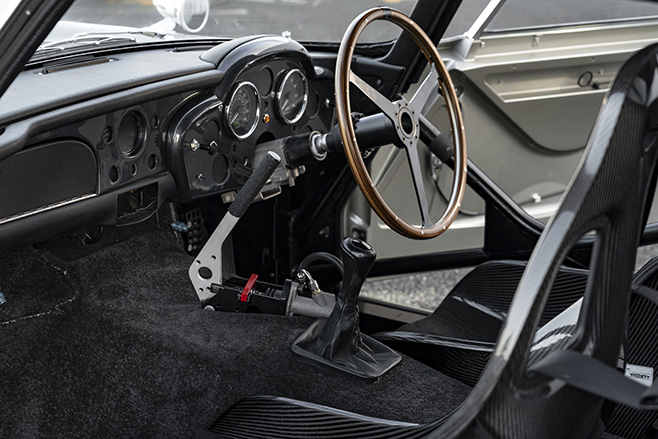
Given that Aston is working on its own six-cylinder engine, it was reticent to mention that the engine powering the stunt cars was the S54 straight-six normally found in the BMW E46 M3. The stunt DB5 also features the M3’s transmission with all that power being directed to skinny Avon racing rubber. No wonder driver Mark Higgins looked happy.

